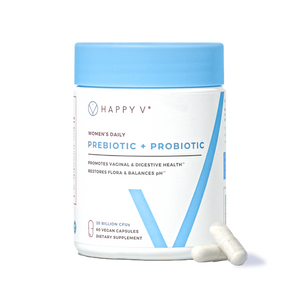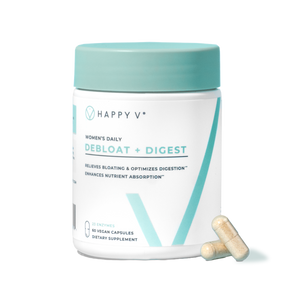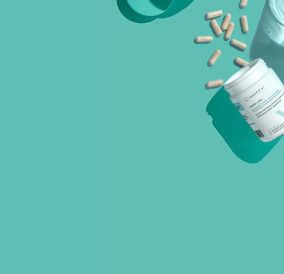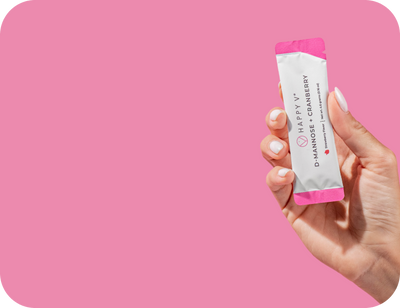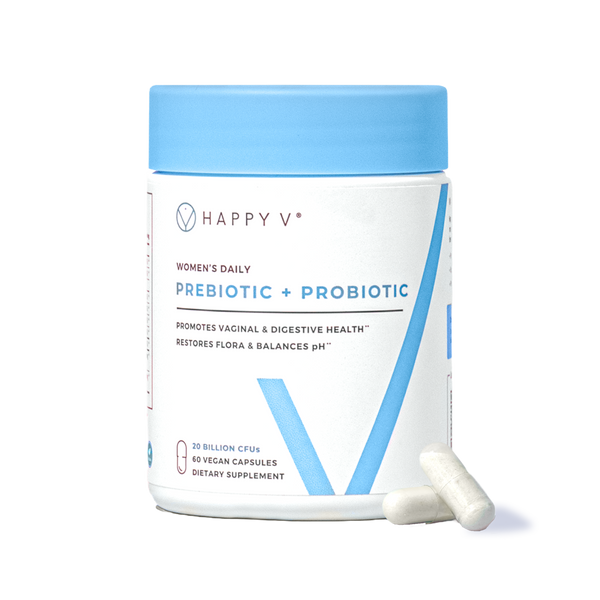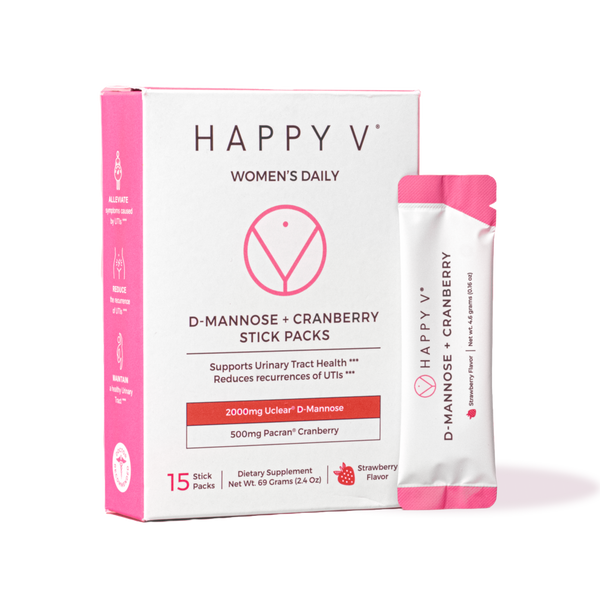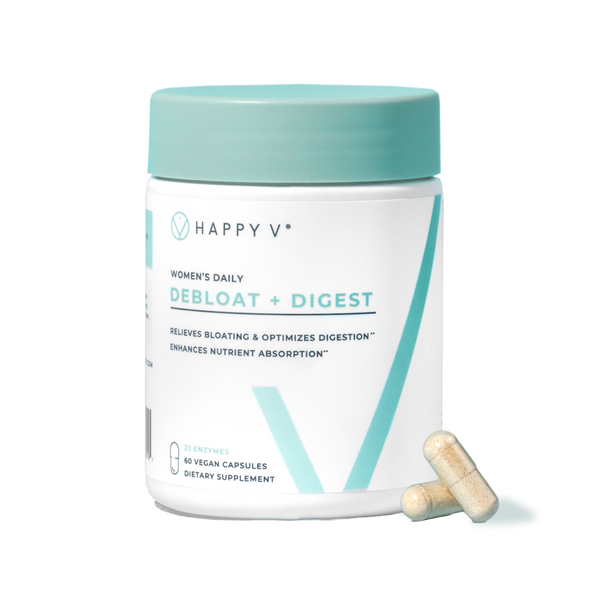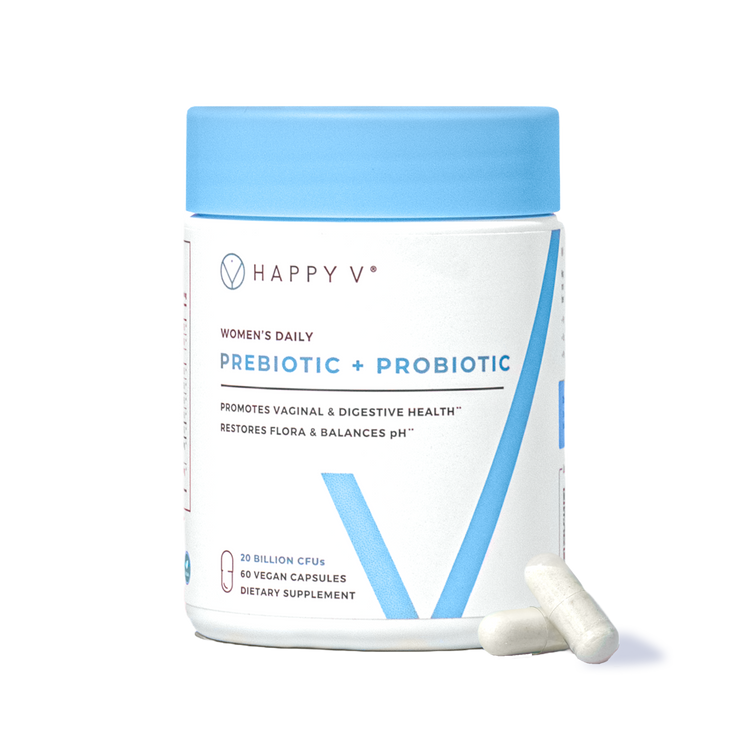- Fact Checked
- November 24, 2025
- 23 min read
Vaginal pH 101: Everything You Need to Know
Table of Contents
Table of Contents
Your vaginal pH is a little number that can tell you a whole lot about your overall vaginal wellness, but it's an aspect of women's health that's often overlooked. We’re here to change that.
Think of this as your complete guide to understanding vaginal pH, including what it is, why it matters, and how you can take control of it. By the end, you'll have the knowledge you need to spot signs your pH is off and get it back on track.
This post is for informational purposes only and does not constitute medical advice. See full disclaimer below.
What is Vaginal pH?
To understand what vaginal pH is, we first need to understand pH in general. pH describes how acidic or basic a particular substance is, measured on a scale from 1 to 14. On this scale, 1 is incredibly acidic (think: stomach acid or lemon juice) and 14 is incredibly basic or alkaline (think: baking soda). Right in the middle at 7, we have neutral, which is the pH of water.
So when we talk about your vaginal pH, we're describing how acidic or basic the vaginal environment is. And your vagina isn't the only part of your body with a specific pH. Your stomach, for example, maintains an incredibly acidic pH between 1.5 and 3.5 to help break down food and kill harmful bacteria1. Your skin is also slightly acidic, with a pH between 4.5 and 6.5, which helps protect against bacteria that could cause infection2.
Why do we mention all these various pH levels? Hopefully, because it helps you understand the purpose of pH across your body, including in your vagina. It’s just one of the many amazing ways your body naturally protects itself.
What is the pH of a Healthy Vagina?
A healthy vagina typically has a slightly acidic pH, ranging between 3.8 and 4.53. This range is most common for women of reproductive age, which is roughly age 12 through menopause.
It’s important to know, though, that vaginal pH isn't static throughout your life. For prepubescent girls or post-menopausal women, the pH level can be greater than 4.54, which is completely normal for those life stages.
It's also worth noting that things like menstruation can cause temporary pH fluctuations (since period blood is alkaline). These short-term changes are usually nothing to worry about. What you want to watch for are more prolonged changes in vaginal pH levels, which can lead to frequent vaginal infections like bacterial vaginosis (BV) or yeast infections.
If you're dealing with recurrent BV and want to dive deeper into the connection between BV and pH, check out our Ultimate Guide to Bacterial Vaginosis.
Why is the Ideal pH of the Vagina Acidic?
We know what you're thinking: "Wait… acid in my vagina?!" But here's the thing—this slight acidity is actually a very good thing. In fact, it's one of your body's most brilliant defense mechanisms.
The acidic pH of your vagina serves several crucial functions. It:
- Keeps your vagina clean by naturally washing away unwanted bacteria and debris
- Removes dead vaginal cells as part of your body's natural renewal process
- Maintains proper lubrication to keep the vaginal tissue healthy and comfortable
- Kills harmful bacteria that could otherwise cause infection
Understanding how your vaginal gets this slight acidity is important, too. The short answer is it comes from beneficial bacteria living in your vaginal microbiome.
These beneficial bacteria, particularly Lactobacillus, convert glucose into hydrogen peroxide and lactic acid5. These two compounds work together to kill harmful bacteria like Gardnerella vaginalis, Atopobium, and Mycoplasma (which cause BV) as well as fungi like Candida albicans (which causes most vaginal yeast infections). They also contribute to your vaginal pH, so a healthy vaginal pH indicates that your vaginal microbiome has the right level of healthy bacteria living in it.
What Happens When My Vaginal pH is Abnormal?
When your vaginal pH rises above 4.5, it's a sign that your Lactobacillus levels have dropped, so you are no longer producing enough lactic acid and hydrogen peroxide. Without these protective compounds, your body loses its natural defense against common vaginal pathogens.
This imbalance leads to increased risk of vaginal infections, bacterial vaginosis (BV) and vaginal yeast infections.
Bacterial Vaginosis (BV)
BV is the #1 most common vaginal infection in women of reproductive age6. According to the CDC, nearly 30% of women in the United States experience BV at least once every year. So if this is you, you are far from alone.
While there is a strong link between certain sexual practices and BV, BV is not considered a sexually transmitted disease (STD) or sexually transmitted infection (STI)7. In fact, you can develop BV without being sexually active.
Common BV symptoms include:
- Unusual vaginal discharge that's usually white or gray8
- Itching or burning sensation around the vulva
- Foul-smelling discharge that many describe as fish-like (often more noticeable after sex)
- Burning sensation during urination
But by some estimates, as many as half of women with BV don’t experience any symptoms. This is why it’s so important to maintain regular appointments with your gynecologist. Even if you don’t experience symptoms of BV, any lingering vaginal infection should be treated. Even asymptomatic BV, if it persists, can lead to serious complications like:
- Increased risk of contracting STDs like herpes, gonorrhea, chlamydia, and HIV
- Pelvic inflammatory disease (PID) in the uterus or ovaries9
- Early labor or preterm birth during pregnancy10
- Increased risk of infections after surgery on your reproductive organs, such as a hysterectomy or cesarean section
The good news is that BV is highly treatable11. Doctors often prescribe antibiotics like metronidazole, clindamycin, or tinidazole to clear the infection12. There are also natural ways to minimize your risk of getting BV, such as taking a daily prebiotic supplement designed to support vaginal health13. These supplements help keep your vagina populated with healthy Lactobacillus bacteria (and all the great lactic acid and hydrogen peroxide that they produce!).
Vaginal Yeast Infections
After BV, vaginal yeast infections (also called vaginal candidiasis, vulvovaginal candidiasis, or candidal vaginitis) are the second most common vaginal infection. Yeast infections occur when the vaginal pH becomes less acidic and can no longer fight off the growth of a yeast called Candida albicans14.
Some yeast infection symptoms, like burning while urinating, can overlap with BV symptoms. That's why it's crucial to see a doctor for an accurate diagnosis rather than self-treating. However, there are key differences you can watch for, particularly in the odor and appearance of vaginal discharge.
Unlike BV, the discharge associated with yeast infections is:
- Odorless (no fishy smell)
- Thick with a cottage cheese-like consistency
- Usually white
Other common yeast infection symptoms include:
- Intense itching around the vulva and vagina15
- Redness and swelling of the vulva
- Burning during urination or sex
- Pain during intercourse
Just like BV, vaginal yeast infections are highly treatable16. Your doctor might prescribe antifungal medications such as fluconazole, which can be taken by mouth, or topical antifungal creams that are applied inside the vagina.
How Can I Tell If My Vaginal pH Levels Are Off?
Here's the challenging part: initial or temporary changes to your vaginal pH are often asymptomatic, meaning they don't show any obvious signs. Your pH could be gradually shifting without you even knowing it.
However, if you develop an infection like BV, a vaginal yeast infection, or a UTI, these are clear signs that your vaginal pH levels are off and your body's natural defenses aren’t as strong as they should be.
Beyond infections, there are other common signs and symptoms of pH imbalance to watch for, including:
- Burning sensation while urinating
- Inflammation in your vagina
- Itchiness around your vulva
- Pain during sex
- Unusual vaginal odor (particularly a fishy smell)
- Unusual discharge (changes in color, consistency, or amount)
- Vaginal dryness
If you're experiencing one or more of these symptoms, reach out to your healthcare provider for an appointment. They will help provide an accurate diagnosis and recommend the most effective treatment.
Can I Check My Vagina's pH at Home?
Yes! If you're concerned or simply curious about your vaginal pH, over-the-counter vaginal pH test kits are available at most pharmacies and are incredibly easy to use.
How to Use a Home pH Test Kit
These kits generally include a swab and a pH-matching color scale. It’s important to read the use instructions for your exact kit, but generally, the steps of a home test kit for pH involve:
-
Wash your hands thoroughly before opening the kit.
-
Carefully remove the swab from its packaging.
-
Insert the swab into your vagina, making sure it touches your vaginal walls.
-
Wait 5 to 10 seconds for the swab to change color.
-
Compare the swab color to the pH matching scale included in the kit to determine your vaginal pH.
It’s important to understand where these tests can be helpful and where they are limited. While home pH testing can give you helpful information about your health, it cannot accurately diagnose infections like bacterial vaginosis. If you suspect you have BV or another vaginal infection, it's important to seek medical attention for a professional diagnosis and appropriate treatment.
What Can Cause My Vaginal pH to Become Off-Balance?
The vaginal microbiome is both complex and delicate, and a variety of factors can cause bacteria levels to become out of balance, altering your vaginal pH. Some of these factors you can control. Others… not so much. Here are some of the most common culprits for vaginal pH imbalances:
Menstruation and Menstrual Blood
As if periods weren't annoying enough already, right? Menstrual blood has a pH greater than 7 (remember, that's basic/alkaline). When this blood stays in contact with your vagina through tampons or pads, it can temporarily disrupt your vaginal pH.
While you can’t exactly opt out of your menstrual cycle, you can mitigate the risk of these temporary disruptions becoming more permanent by changing tampons and pads frequently (like every 2-4 hours, depending on flow). The longer blood sits in contact with your vaginal tissue, the more opportunity it has to alter your pH balance17.
Tight or Non-Breathable Underwear
Most women's underwear is made from silk or nylon, and while these materials might look and feel nice, they're not ideal for vaginal health. These synthetic fabrics are non-breathable, meaning they trap moisture and heat. And warm, moist environments are pretty much breeding grounds for bad bacteria growth.
Switching to cotton underwear allows for more air circulation and helps keep the vaginal area dry, which supports a healthy pH balance by preventing bad bacterial overgrowth.
Scented Vaginal Creams, Lotions, and Cleansers
Many vaginal creams, lotions, and gels contain chemicals that can alter your vaginal pH levels, especially if they are scented. Some of the biggest offenders are vaginal deodorants, scented soaps, and perfumed body washes marketed specifically for intimate use.
Even though these products claim to "cleanse" or "freshen" your vagina, they can actually make the area less hygienic by disrupting your pH balance and increasing your likelihood of infection. More than that, they’re completely unnecessary! Your vagina is self-cleaning and doesn't need these products.
Our advice—and the advice of medical professionals—is to ditch these products in favor of daily vulva cleansing with gentle, unscented soap and warm water.
Douching
Douching is another "cleansing" method that almost all OB/GYNs strongly advise against, and for good reason. When you douche, you're essentially washing away the good Lactobacillus bacteria that keep your vaginal pH balanced18. This puts you at significantly greater risk for infections.
Like we said, your vagina is designed to clean itself naturally. Douching interferes with this process and does more harm than good.
Overuse or Misuse of Antibiotics
Let's make one thing clear right at the start: antibiotics are often the best and most effective way to eliminate serious bacterial infections, and they serve an important medical purpose. But they're not without risks and should only be used when necessary, not as a preventive measure or for prolonged periods.
Antibiotics work by killing bacteria, but they can't distinguish between good bacteria and bad bacteria19. This means that while they're eliminating the infection-causing bacteria, they're also wiping out the beneficial Lactobacillus bacteria living in your vaginal microbiome. Without these protective bacteria, your vagina becomes more vulnerable to pH imbalance and subsequent infections, like vaginal yeast infections.
If you need to take antibiotics, consider pairing them with a daily probiotic supplement to help replenish the good bacteria your body needs.
Prebiotic + Probiotic
Maintains vaginal pH and restores gut health.
Prebiotic + Probiotic
Maintains vaginal pH and restores gut health.
Birth Control Methods
Certain birth control methods can affect your vaginal pH20. This doesn't mean you should avoid them, just that you should be aware of the potential impact. Birth control methods that may alter vaginal pH include:
- Hormonal birth control pills
- Intrauterine devices (IUDs)21
- Spermicides
- Diaphragms22
- Cervical caps
These methods can change the hormonal environment or introduce substances that affect the delicate balance of your vaginal ecosystem. If you notice recurring infections after starting a new birth control method, talk to your healthcare provider about your options.
Poor Hygiene and Improper Wiping
Even though we're down at risk factor number seven on this list, this is actually one of the most common reasons for poor vaginal health. Common hygiene mistakes include:
- Not cleaning your vulva area after sexual intercourse
- Wearing tampons or pads for too long
- Not wiping correctly after using the bathroom
You read that right. There is a correct way to wipe, and it’s always from front to back. This prevents bacteria from the anal area from being transferred to your vagina and urethra, which can cause both pH imbalance and UTIs.
Having Unprotected Sex
Here's something fascinating: the job of semen is literally to elevate your vaginal pH! Semen has a higher pH (around 7-8)23, and when it comes into contact with your vagina, it temporarily raises the pH to make the environment more hospitable for sperm to swim.
Generally, this pH elevation is temporary, and your vagina returns to its normal acidic state afterward. However, frequent unprotected sex can raise vaginal pH levels more permanently, making you more susceptible to infections.
Additionally, unprotected sex exposes you to potentially harmful bacteria and microbes from your partner's microbiome, which can further disrupt your vaginal balance.
Menopause
Estrogen is an essential hormone for vaginal health24. It helps keep your vagina lubricated by promoting glycogen production and supporting normal vaginal discharge25. During menopause, however, estrogen levels drop significantly.
This hormonal shift leads to several changes, including an increase in vaginal pH. Typically, women experiencing menopause have a vaginal pH level above 5.326, which is higher than the 3.8-4.5 range seen during reproductive years.
This pH increase is one reason why post-menopausal women often experience vaginal dryness, irritation, and an increased susceptibility to infections. Hormone replacement therapy or vaginal estrogen treatments can sometimes help, so talk to your healthcare provider about your options.
Pregnancy
Just about everything changes when you're pregnant, and your vaginal pH is no exception. Hormonal fluctuations during pregnancy can lead to pH imbalances.
More than that, during pregnancy, your immune system is naturally weakened to prevent your body from rejecting the developing fetus. This means pregnant women are also more susceptible to vaginal infections, which is why regular prenatal care and monitoring are so important. If you notice any unusual symptoms during pregnancy, don't hesitate to contact your healthcare provider.
Having Multiple or New Sex Partners
Who you choose to have sex with is always 100% your decision. But if you're struggling with pH imbalance and frequent infections, it's important to understand that new sex partners introduce your body to new bacteria and microbes.
Each person has their own unique microbiome, and when these microbiomes interact during sex, it can temporarily disrupt your vaginal balance. This doesn't mean you can't have multiple partners; it just means you should be mindful about protection and maintaining good vaginal hygiene practices.
Lubricants
Lubricants are used to reduce vaginal dryness and make sex more comfortable, and there's absolutely nothing wrong with using them. However, many commercial lubricants have a pH higher than 4.5, which can elevate your vaginal pH.
If you use lubricants regularly and struggle with infections, look for pH-balanced lubricants specifically designed to match your vagina's natural acidity (around 4.5). Water-based lubricants are generally preferable to oil-based ones.
Not Changing Wet or Sweaty Clothes
Remember how we said bad bacteria that cause infections love warm, moist environments? This doesn’t just include synthetic underwear. Other bad bacteria-loving environments include:
- Sweaty workout clothes
- Wet swimsuits
- Hot tubs and saunas
- Tight-fitting clothing after exercise
Of course, this doesn't mean you should avoid working out, swimming, or relaxing in a hot tub. It just means you need to be mindful about changing out of damp clothing—and especially underwear—as soon as possible. Don't sit around in wet gym clothes or swimsuits for extended periods.
Can My pH Levels Become Unbalanced if I'm Not Having Sex?
Totally While you may have noticed that that sex and unprotected sex play a role in vaginal pH imbalance, many other causes are completely unrelated to sexual activity. Antibiotic use, poor hygiene, tight clothing, menstruation, and hormonal changes can all affect your pH regardless of whether you're sexually active.
BV and yeast infections can—and do—occur in women who aren't sexually active.
What Can I Do to Restore or Maintain a Healthy Vaginal pH?
We're so glad you asked. The good news is that there are many practical, evidence-based strategies you can use to support a healthy vaginal pH. Here are the most effective approaches:
Take Daily Probiotics
Lactobacillus probiotics are essential for maintaining a healthy vaginal pH27. Lactobacillus levels drop, pH can rise, paving the way for infections and discomfort.
One of the easiest ways to increase your levels of probiotics is to take a high-quality probiotic supplement that was designed with vaginal health in mind, meaning it contains clinically proven strains like L. acidophilus LA-14®, L. rhamnosus HN001™, L. reuteri HR7™, and L. gasseri HLG13™. These strains have all been studied and have been shown to help restore balance, crowd out unwanted bacteria, and support overall vaginal wellness.
Happy V’s Prebiotic + Probiotic contains these clinically proven strains and more. In fact, our unique blend was shown in preclinical studies to:
- Inhibit harmful bacterial growth, including organisms linked to pH imbalance
- Reduce the growth of several Candida species, including C. albicans and C. glabrata, while supporting beneficial bacteria
Together, these findings highlight how Happy V’s targeted probiotic blend helps maintain vaginal pH and support long-term microbiome balance.
Stay Hydrated
Drinking plenty of water isn't just good for your overall health; it's specifically beneficial for vaginal health. When your body is well-hydrated, it helps flush out unwanted bacteria from your vagina, particularly those known for disrupting vaginal pH.
Aim for at least 8 glasses of water per day, and more if you're exercising or in hot weather.
Eat a Nutrient-Rich Diet
A balanced diet plays a powerful role in maintaining vaginal and urinary tract health. Prioritize foods rich in vitamins and nutrients that help regulate pH, reduce inflammation, and strengthen your body’s natural defenses. These include foods high in:
- Vitamin C, like citrus fruits, bell peppers, strawberries, and broccoli. They support immune function, collagen production, and antioxidant protection28.
- Vitamin E, like nuts, seeds, and avocados. They help protect cell membranes and supports tissue repair29.
- B Vitamins (especially B2, B6, and B12), found in eggs, leafy greens, whole grains, and legumes. They support energy production and healthy mucous membranes.
- Vitamin D, found in fortified dairy, fatty fish, and sunlight exposure. It plays a role in immune regulation and vaginal microbiome balance.
- Zinc, found in pumpkin seeds, lentils, and seafood and supports healing, immunity, and cellular health30.
- Magnesium, which is found in leafy greens, almonds, and bananas and aids in muscle relaxation and inflammation control31.
Cut Down on Sugar Intake
Artificial sugars in beverages, sweetened cereals, candy, and processed foods can cause spikes in blood sugar levels. Elevated blood sugar can suppress your immune system, creating an environment where harmful bacteria and yeast can thrive.
This is particularly important if you're prone to yeast infections, as Candida (aka the yeast that causes most of these infections) feeds on sugar.
Avoid Vaginal "Cleaning" Products
Ditch the vaginal deodorants, scented washes, and douches. These products introduce chemicals that can disrupt your vaginal pH and actually increase your risk of infection.
The best way to stay clean is simple: wash your vulva (the external area) with warm water and mild, unscented soap. Your vagina (the internal canal) cleans itself and doesn't need any special products.
If you're concerned about vaginal odor, don't try to cover it up with scented products. Instead, make an appointment with your doctor to identify and address the underlying cause.
Use Antibiotics Judiciously
Take antibiotics only when truly necessary for acute bacterial infections. Avoid requesting antibiotics for viral infections (they won't work anyway) or using leftover antibiotics from previous prescriptions.
When you do need to take antibiotics, pair them with a daily probiotic supplement to help replenish the beneficial bacteria in your body. Take your probiotic at least two hours apart from your antibiotic dose to prevent the antibiotic from killing the beneficial bacteria in your supplement.
Choose Cotton Underwear
Cotton is significantly more breathable than silk, nylon, or other synthetic materials. This allows air to circulate around your vagina, preventing moisture buildup and creating an environment that discourages harmful bacterial growth.
Look for underwear that's 100% cotton in the crotch area, even if the rest of the garment is made from other materials.
Clean Sex Toys Thoroughly
Clean all sex toys before and after every single use with appropriate toy cleaner or mild soap and water. This prevents bacteria from growing on the toys and prevents you from reintroducing bacteria that could cause reinfection after treatment for a vaginal infection.
Consider Latex-Free Condoms
If you're having protected sex but still struggling with pH imbalance and infections, consider switching to latex-free condoms. Some people have sensitivities to ingredients in latex condoms that can cause irritation and pH changes.
Try polyurethane or polyisoprene condoms instead to see if they work better for your body.
Keep Stress Levels in Check
Chronic stress affects your entire body, including your vaginal health. The cortisol produced during prolonged stress can impact your vagina's pH regulation and weaken your immune system, making you more susceptible to infections.
Incorporate stress-management techniques into your routine like regular exercise, deep breathing, time with friends, and plenty of sleep.
Never forget that your mental health and physical health are deeply connected—taking care of one supports the other.
When to Seek Medical Attention
Most mild pH imbalances can be managed with healthy habits and preventive care—but some symptoms require professional attention. Contact your healthcare provider if you experience:
- Severe or worsening symptoms like intense pain, significant swelling, or high fever.
- Heavy or unusual bleeding outside your period, especially with pain or foul-smelling discharge.
- Any vaginal symptoms during pregnancy, since untreated infections can affect you and your baby.
- Symptoms lasting more than a few days or recurring infections (three or more times a year).
- New or unusual changes in discharge, odor, or pain during urination or sex.
- No improvement with over-the-counter treatments. You may be dealing with something other than a yeast infection.
- Uncertainty about your diagnosis. Remember BV, yeast infections, and other vaginal issues often overlap.
- Post-surgical or post-procedure symptoms, or if you’re preparing for reproductive surgery.
- After sexual assault—seek immediate care and support.
- If you have a weakened immune system due to HIV, diabetes, or chemotherapy.
- If symptoms begin after starting new medications, including birth control.
Bottom line: Trust your instincts. If something feels off, get checked. Early evaluation can prevent complications and help you heal faster.
Frequently Asked Questions
Is It Normal for Vaginal pH to Fluctuate?
Yes, some fluctuation is completely normal. Your vaginal pH can change temporarily during different phases of your menstrual cycle, during and after your period, after sex, and due to stress and overall diet. What you want to watch for are persistent pH imbalances that last for weeks or lead to symptoms, like unusual discharge, odor, or discomfort.
Can I Have Sex While My pH is Off?
You can, but it’s probably not a great idea. Having sex when your pH is imbalanced can not only be uncomfortable, but it can actually worsen the imbalance. If you have an active infection like BV or a yeast infection, sex can also spread bacteria to your partner or cause reinfection even after you’ve finished your course of antibiotics. Most healthcare providers say it’s generally best to wait until your pH is restored and any infection is treated. When you do resume sex, use condoms and wash the vulva area afterward.
How Long Does it Take to Restore Vaginal pH Balance?
This depends on what caused the imbalance and how you're addressing it. With proper treatment (such as antibiotics for BV or antifungals for yeast infections), symptoms often improve within a few days to a week. However, fully restoring and maintaining a healthy vaginal microbiome can take several weeks to a few months of consistent healthy habits, including taking probiotics, avoiding irritants, and following good hygiene practices. As with anything health-related, consistency is key.
Do Certain Foods Affect Vaginal pH?
Yes, your diet can influence your vaginal pH. High-sugar diets can promote yeast growth and disrupt pH balance, while foods high in vitamin C, zinc, and magnesium can support healthy pH levels. We actually have a whole article about the best and worst foods for vaginal health that you can read here.
Is It Safe to Use Home pH Test Kits Regularly?
Yes, home pH test kits are safe to use and can be a helpful monitoring tool, especially if you're prone to pH imbalances or infections. Just don't rely on them for diagnosis. If your home test shows an abnormal pH or you have symptoms, follow up with your healthcare provider for proper testing and treatment. Also, avoid testing during or immediately after your period, as menstrual blood will temporarily affect pH readings.
Final Thoughts
Your vaginal pH might seem like a small detail, but it plays a huge role in your overall vaginal health and well-being.
Remember, maintaining healthy vaginal pH is about consistency and making informed choices that support your body's natural protective mechanisms. Whether that's choosing the right probiotic, wearing breathable underwear, or simply being more mindful about the products you use, every small step contributes to better vaginal health.
And if you're dealing with recurring infections or persistent pH imbalances, don't suffer in silence. Reach out to a healthcare provider who can help you identify the underlying causes and develop a treatment plan that works for your unique situation.
Keep the Conversation Going
- Visit our blog for more women's health tips and evidence-based information.
- Join our private Happy V Facebook group to connect with other women who understand what you're going through.
- Explore our supplements designed specifically to support your vaginal health journey.
Disclaimer: This blog is for informational and educational purposes only and is not intended to diagnose, treat, cure, or prevent any disease. Statements about supplements have not been evaluated by the Food and Drug Administration. For more information about vaginal infections, visit the CDC or speak to a licensed healthcare provider.
